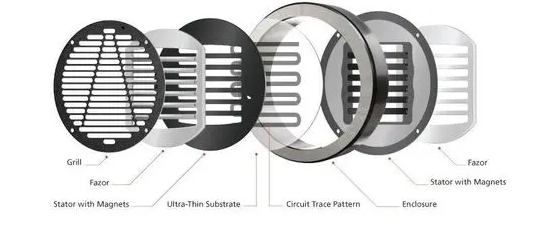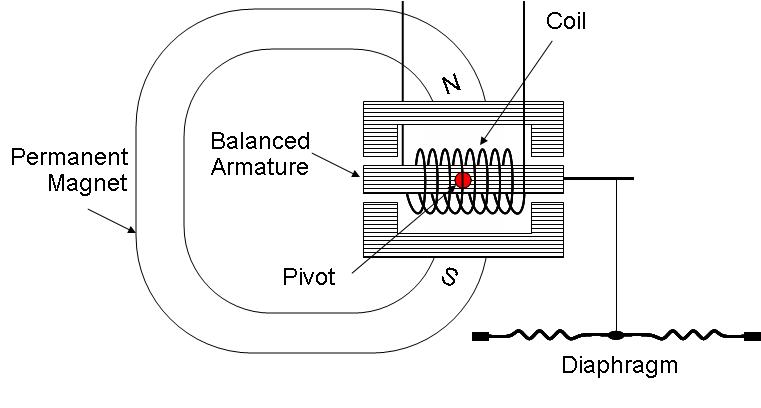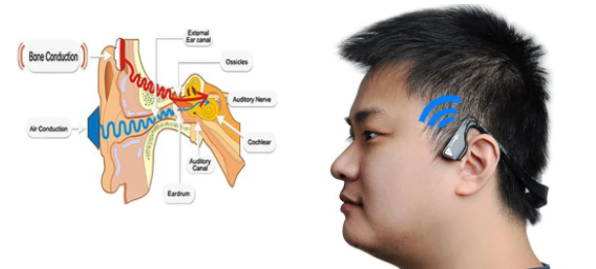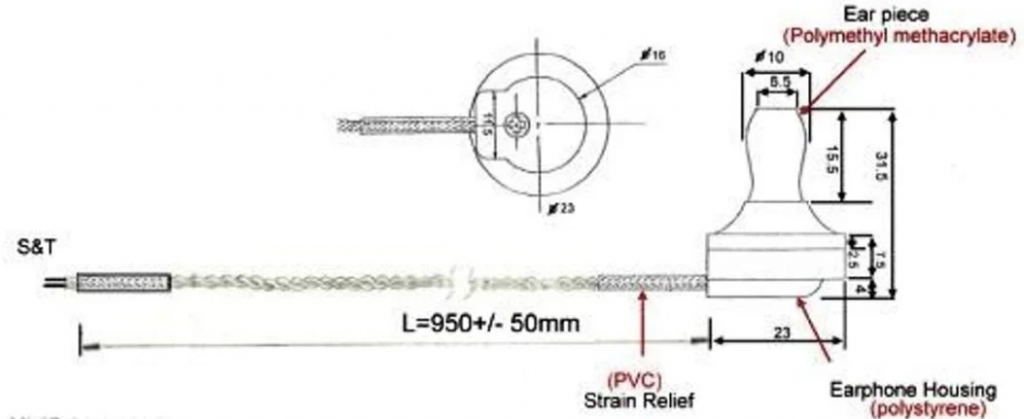Types Of Speaker Drivers In Earphones And Headphones

In today’s world, headphones and earphones are among the most commonly used accessories, along with smartphones.
If you are searching for quality headphones, you will be amazed that there are plenty of quality headphones available. Choosing the right headphones can be challenging.
It is difficult to pick the right headphones (or earphones) by just looking at their specifications since they are complex and very technical.
In this blog post, we will discuss some common types of speaker drivers present inside our earphones and headphones to give an overview of how these drivers affect audio quality.
So, let’s get started without further ado!
What is a Headphone Driver Unit?
In headphones and earphones, the driver is the most important feature because it converts electrical signals into sound. So, the driver is responsible for producing sound. Drivers usually consist of three components that work together to produce sound. These components are following:
Magnets
The magnetic fields generated by the driver of headphones have an influence on the sound quality. The stronger the magnets the more sound it can produce, depending on driver dimensions. Higher magnets may increase airflow thereby increasing frequency coverage for drivers. It is hardly overstated, though the optimization and the quality of other component elements can affect sound quality.
A magnet acts to make speakers drive as the diaphragm rotates and vibrates resulting in sonic waves and air vibrations. Magnets for headphones are usually made of cobalt and ferrite and occasionally a rare material is applied to produce stronger magnets than others.
Voice coils
The voice coil is a physical force that contacts the diaphragm to induce vibratory energy on its surface. The electrical energy that runs on voice coils becomes electromagnetic in which the magnetic fields interact. The contact attracts and removes the coils vibrating and moving diaphragms. It’s possible that voice coils are constructed of many kinds – most are largely made with copper. HI-OFC and PCOCC copper products are offered.
Diaphragm
The airflow of the diaphragm oscillates to generate sound that can be heard in your ear. Usually, this membrane consists of several layers with different materials with suspended sides for vibrations. When electricity passes through the microphone wire and the diaphragm, the membrane vibrates a small air bubble which creates an air-filled sound in your speaker system.
Do More Drivers Mean Better Sound?
Headphones with larger drivers may not necessarily provide a higher level of noise. Yes, having more drivers on the headphone amplifiers can increase their frequencies but without sacrificing precision. But you cannot simply determine based on how many drivers you use for your headphones.
Instead of the numbers, it would be nice to examine the tuning and integration of the drivers with the headphones. Headphones with multiple drivers usually use two separate components for producing multiple frequencies: driver A makes the bass and mid; driver B produces the treble. An electrical circuit called the crossover mixes all these frequency levels for an extended sound dynamic.
Types Of Speaker Driver Units Inside A Headphone/Earphone
The drivers used on headphones play a crucial role in sound quality. The following are the 6 most common types of speaker drivers found in earphones and headphones.
Planar Magnetic Driver

Planar magnetic drivers are commonly found in high-end headphones. Like dynamic driver units, planar magnetic drivers work on the principle of electromagnetism. In recent years, in-ear headphones have gained popularity, although they are typically used with over-ear headphones and open-back headphones.
RHA’s CL2-polar magnet earbuds have been introduced. This technique consists of a diaphragm inserted within a magnet. Compared to dynamic drivers, planar magnetic drives work in magnetic fields. But rather than using coiling, it can be directly shaped through magnetic fields and produces sound. Added magnets can be used to produce a uniform diaphragm vibration. The headsets are lighter. Premium headphones usually use these types of drivers.
Dynamic (Moving Coil) Driver

Dynamic driver units are commonly found in headphones and earphones. Basically, it is made up of three parts: a magnet, a voice coil, and a diaphragm.
They use a magnet, typically neodymium, that interacts with their microphone’s coil. When the current is running through it, voice coils start oscillating and the diaphragm also oscillates following a similar cycle.
The diaphragmatic oscillations move air towards the front and produce sounds. Those who want an excellent bass response choose the headsets with dynamic drivers. This driver is widely used on headphones and features larger diaphragms.
Balanced Armature Driver

On In-Ear monitor earphones, you’ll find balanced armature drivers. These are tiny drivers which are often operated using a monitor. Because of this size, manufacturers may place several drivers on one earpiece. Generally, most headphones have two to four driver models.
This earphone is capable of reproducing a variety of frequencies without distortion. Bass notes can normally be handled separately by a driver; rests are managed by the remaining ones. These driver forms are composed of a coil wrapped around an arm.
Electrostatic Driver

Electrostatic headphones have a very small market because of their high price and specific applications. Unlike dynamic and linear magnetic drivers operating by electromagnetism, electrostatic drivers operate by using static electrical current. Electrostatic drives contain an ultra-thin and lightweight diaphragm suspended in two metal plates known as stators and the plates are perforated in an airflow manner.
The positive and negative charges are both in two plates. When sounds are applied to a surface, a magnetic field arises. Electric fields draw and repel diaphragms from and around plates.
Magnetostriction Or Bone Conduction Driver

A bone conduction driver is also known as a magnetostriction driver. A bone conduction driver works differently from other earphone drivers and is a relatively new technology.
Although bone ducting headphones are relatively new to the field, these devices are becoming more popular with fans and regular consumers alike. Several bone-conductors headphone brands have been introduced including Shakz Aeropex which was introduced in 2010.
Bone Conduction headphones do not utilize your eardrum and can be extremely helpful if you are suffering from a hearing problem due to damaged eardrums. While many experts disagree about bone conduction headset safety, many people have found bone conduction headphones to cause headaches, skin inflammation, and pain.
Hybrid Driver

Hybrid drivers are those that combine at least two or more different drivers in one headphone. A good example of a hybrid drive is the dynamic and balanced armature (BA) combination.
Hybrid drivers in headphones produce the rich, detailed sound that you won’t find anywhere else. This is because they use two or more different kinds of speakers to ensure every frequency range sounds good and vibrant with life-like proportions – even if it’s below 20Hz where most humans can’t hear these low frequencies.
Does Headphone Driver Size Matter?
In short, yes, the size of the driver in your headphones has a specific influence on their sound quality. However, this does not mean that larger drivers always sound better. By moving more air particles, larger drivers can indeed create louder sounds. Compared to smaller drivers, they need to vibrate less to move the same amount of air particles.
The louder the driver, the more a larger air particle will move to create the louder sound. A smaller vehicle has fewer articular forces that move more air. Airflow dictates the amount of air you’re generating. The greater variations in pressure mean the larger frequency range (higher highs and deeper lows). It gives an impression of bigger drivers, providing better sound and responsive bass response.
How Does A Speaker Driver Produce Sound?
When the speaker is plugged into the host device – usually a computer or smartphone – an electrical signal is sent to the headphone/earphone, and it magnetizes the voice coil.

The voice coil oscillates and pushes the air column in front of it. Vibrations from the pulsating diaphragm push the diaphragm back and forth, creating audible sound.
FAQs For Types Of Speaker Drivers In Earphones And Headphones
Does Having Multiple Drivers Provide Better Sound Quality?
It’s not necessary to have multiple drivers to generate better quality sound. With multiple driver headphones, a single driver controls bass, mids, and treble frequencies. This should be sufficient enough to improve audio quality. Poor-quality multidriver devices are more effective than high-tech single drivers.
Multiple drivers are no longer necessary because drivers’ capabilities have increased in recent years and we are better equipped to tune headphones’ audio.
What Is The Best Driver Size For Earphones And Headphones?
The best driver size for earphones and headphones depends on their design. Typically, headphone drivers are 20mm – 50mm in diameter, while earphone drivers are 8mm – 15mm. Larger drivers produce stronger sound waves (especially in the bass and sub-bass), but this does not necessarily mean that they sound better.
Do Headphones Have A Driver?
Yes, Speakers and Headphones have drivers. Its vibrations are what make a sound that is heard. Most premium speakers are equipped with a perfectly flat round square rectangular planar magnetic or electrostatic driver. Usually, the sound is generated through the air.
What Are Drivers In Earphones?
This component converts electrical energy into acoustic energy and sometimes motorized energy into electrical energy. A drive serves an integral function in a speaker’s sound. As the different size of headphones and IEM shows driver size can also be quite different for different devices.
Conclusion
As you can see above, we’ve explained different types of Speaker Drivers in Earphones and Headphones. We hope that you found this article useful and this piece of information will help you purchase better-sounding earphones or headphones in the future.
When purchasing a headphone/earphone, even knowledgeable people think only of the size of the speaker driver. In the meantime, even a larger driver may not be able to produce better sound quality, which you now know why.
We recommend that you invest in an electrostatic driver-powered headphone if you are sound engineering professional. If you’re on a tight budget, you should purchase a regular dynamic driver headphone/earphone.
If you have any questions about this topic, please let me know in the comment section below.
Thank you for visiting our website and have a wonderful day!